|
+Plastic Part Design workshop
.: a Symposium for Product Designers
and Mechanical Engineers :.
Course Duration:
16 hour workshop
(This two day class is offered each month so check the design engine class
schedule for exact dates.)
Tuition: $1000.00 US
Overview: The course material is designed
to provide a working knowledge of the plastics industry thru intelligent
discussions and lectures. The bulk of your time in this workshop will
be spent on the part design requirements imposed on the designer by the
injection molding process.
Prerequisites: General knowledge of Pro/ENGINEER
another 3dimensional CAD modeler helpful but not necessary.
Call to ask for a proposal to sign up your company into a week long on-site
cumulative workshop that encompasses all three manufacturing processes
classes design engine offeres. In this way participants can master and
leverage advanced modeling techniques with specific manufacturing processes
that makes for lighter, stronger parts with confidence. These classes
can be offered anytime requiring only two to make a class in our Chicago
office. 312.226.8339
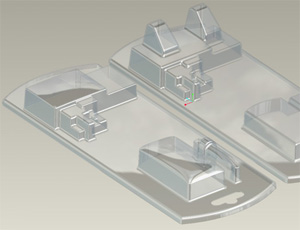 In
this exercise the participants will utilize shrinkwrap to create clamshell
parts for packaging. In
this exercise the participants will utilize shrinkwrap to create clamshell
parts for packaging.
Topics:
- The process, injection molds, vacuum formed, tooling, processing factors,
Nominal Walls, Radii and draft angles, Ribs, Weldlines, stress, cooling
plastics, bosses, undercuts,
- Discuss use of Snap fit, FEA, Design recommendations, flow mold analysis
software.
- Learn to Design injection molded undercuts
- Learn about various plastics and their material characteristics
- Engineers will learn to utilize tooling and injection molders as a resource
to design better parts.
- Learn about the metal mold itself and many of its intricacies such as
sleeve ejection, how it is cooled, sprue and runner, ejector bars, ejector
plats, and ejector pins.
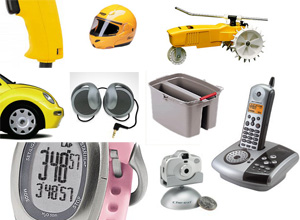
Discussions:
- History of plastics
- How an injection mold functions in detail. Include mold fill short shots
and cooling.
- How China plays a major role in injection molding. Discuss the quotation
process for tooling and discuss partnering with local injection molders
vs. outsourcing. Discuss strengths and weakness of outsourcing.
- Discuss basic design elements in plastic part design. Holes, ribs, thin
wall features, bosses, nominal wall, and fill.
Discuss general rules for hollow boss design and discuss best practices.
Learn about thin steel or thin blade areas and discuss ways to avoid.
Discuss gating and discuss problems such as fill vent and eject issues
as related to. Also discuss how to design in solutions to would be cosmetic
problems.
- Glass filled and co-injection process and discuss problems associated.
Discuss ways to add structural integrity to glass filled parts by aligning
glass filler.
Discuss sink marks and discuss how to avoid using relations in parametric
software
- Cooling time as related to thick sections of plastic. Discuss internal
voids and fundamentals of other problems that occur from improper piece
part design.
- Using parametric modelers in general and discuss examples where using
variables with a parametric modeler can save problems in the future with
examples in your favorite parametric modeler.
- Discuss FEA and stress associated with plastic piece part design with
respect to FEA. Keeping in mind the deliverable for FEA is simply to make
design recommendations discuss the possible solutions to many of the common
molding problems. Keep in mind shrink, stress from sharp corners as related
to cavity filling.
- List plastic vendors and discuss their role and how designers can leverage
their experience.
Discuss the Society of Plastics engineers and their significance in the
industry
- Discuss tooling and different materials for mold design. Discuss from
a machining point of view and compare to cutting graphite for electrode
burning of steel.
- How to improve flow of the plastic through the mold and discuss Flow
Molding analysis software
- Designing undercuts and discuss advantages and disadvantages as relative
to costs
- General disclaimers on drawings such as "brake all sharp corners".
- Different types of undercuts and side pull options (can be customized
if prearranged with CAD manager of your various company)
- Discuss what challenges (flow, cooling, ejection, handling, maintenance)
a mold designer faces when designing a mold and briefly describe in detail
using your favorite parametric software an example for creating the cavity
and splitting apart the mold base
- Draft as related to surface texture kits. Discuss how to call out textures
on your favorite drawing program with examples.
- List 10 different plastics discuss their material characteristics
- Learn about relativly new plastics processes such as gas assist.
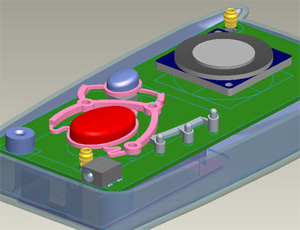 co-injected
Santoprine with polycarabonate buttons, lightpipe and brass PEM inserts co-injected
Santoprine with polycarabonate buttons, lightpipe and brass PEM inserts
Discussions with respect to Pro/ENGINEER:
- Draft in it's many forms complete with examples of split draft etc.
- Light use surfacing and its use with plastic part design.
Discuss top down design with examples.
- Adding draft to parts that currently have no draft.
Discuss making parts moldable that others created.
- Tips tricks and techniques for starting and completing plastic parts
using Pro/ENGINEER.
- Learn to use parameters to drive geometry relative to nominal wall thickness.
- B-Side geometry creation techniques including PEM inserts, bosses and
ribs.
- Utilize Draft check correctly
Participants will be able to leverage password protected HTML training
materials for later use after this workshop.
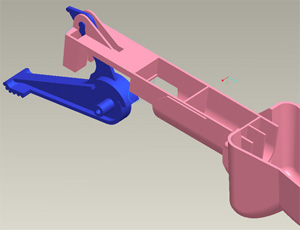 These
Pro/E parts do not currently have draft on them. In this exercises the
participants will are required to add draft onto these parts making each
part moldable. In the end participants will utilize draft check to make
sure of moldability. These
Pro/E parts do not currently have draft on them. In this exercises the
participants will are required to add draft onto these parts making each
part moldable. In the end participants will utilize draft check to make
sure of moldability.
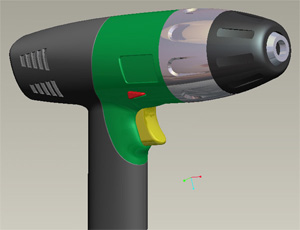 In
this exercises the participants will be required to utilize top down design
to locate hole locations for bosses and buttons making the assembly easy
to modify. Move a hole location and the boss and hole both move in all
parts together. In
this exercises the participants will be required to utilize top down design
to locate hole locations for bosses and buttons making the assembly easy
to modify. Move a hole location and the boss and hole both move in all
parts together.
Compare:
- Compare plastic injection process to die casting
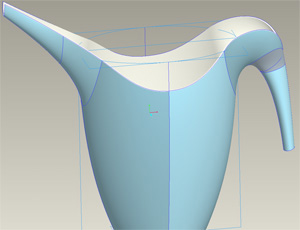 In
this exercises the participants will modify a curves and surfacing model
so there is a positive pull with respect to a specific pull direction.
Currently this model is not moldable with a single pull mold. In
this exercises the participants will modify a curves and surfacing model
so there is a positive pull with respect to a specific pull direction.
Currently this model is not moldable with a single pull mold.
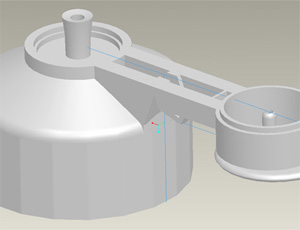 After
discussing live hinges in some detail participants in this course will
look at suggestions for specific materials and modify or create a live
hinge that will meet spec sheets supplied. After
discussing live hinges in some detail participants in this course will
look at suggestions for specific materials and modify or create a live
hinge that will meet spec sheets supplied.
|